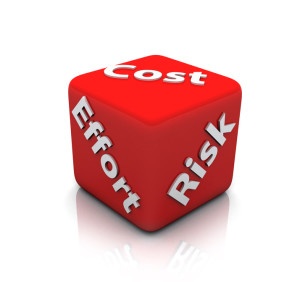 I met with a client last week to discuss how to use our modeling tools to create a better business case. We made good progress on the technical elements of the case – the ROI, payback period, IRR – but when we got to the qualitative parts of the case, we needed to take a step back and rethink how we represented the opportunity costs associated with this particular campaign.
I met with a client last week to discuss how to use our modeling tools to create a better business case. We made good progress on the technical elements of the case – the ROI, payback period, IRR – but when we got to the qualitative parts of the case, we needed to take a step back and rethink how we represented the opportunity costs associated with this particular campaign.
We can easily quantify a cost of delay to motivate the client to move faster, but that assumes an imminent decision in your favor. What about the next best option? How do you place value on it? Today’s blog will focus on opportunity costs and why they’re as equally important as the financials to capture in a business case. Opportunity cost is defined as the benefit that could have been gained from an alternative use of the same resource.
That resource can be time or money or people, and, whether you think about it or not, you’re faced with opportunity costs every day. I’ll highlight a few personal and professional scenarios where opportunity costs come into play, and then I’ll ask you for some feedback on how you think about opportunity costs. Opportunity costs don’t appear on financial statements, but they carry real value - not thinking about them can blindside you. Your life – opportunity costs are always trade-offs. Time is our most valuable asset, and we reap the consequences of how we spend it.
Marathon training - the example that haunts me every day. I signed up for a race this fall, and chose a pretty flexible training plan. I have to admit, though, that some mornings I choose to sleep in rather than put in the miles for the day. Classic opportunity cost – I chose the value of staying in a warm bed over the value of building up my mileage base. The potential consequence? That the marathon is a lot more painful than it needs to be. Just thinking about it makes me want to go out and run right now – but I cannot because the opportunity cost of not completing this blog outweighs the fear of a painful race. Your sales - time management is key to sales success.
It’s a balancing act to build a qualified pipeline, to close deals, and to meet a high level of client satisfaction. Every hour counts. We’ve all gone after that one big deal that would blow out the number and buy you an extra week or two of vacation. But, watch out for the opportunity costs of taking it too easy – time on the beach takes time away from prospecting and building pipeline. You need the next big deal, and all of the smaller ones in between.
Your customers – you’ve been there – you’ve worked on a 6 month sales cycle and it seems like the end is near. You may be aware of how much budget is allocated, or of the process to request and receive budget. You might even know what competitive offerings they’re considering. But then the decision comes down – the ‘‘we’re choosing not to do anything at this time” decision.
You thought you had all of the bases covered – how did this happen? Did you know if your customer could get better returns if they invested the capital elsewhere? Could they get more done if they allocated staff to a different project?
Often the unconsidered opportunity costs, like whether they should do anything at all, surprise you when you’re not looking for them. The hidden “do nothing” option can sneak up on you. How do you think about opportunity costs when making a decision? How do you account for opportunity costs in your business cases and proposals?
This is part art and part science – and there are many ways to do it – so I’m interested to learn what you think. Let me know.
